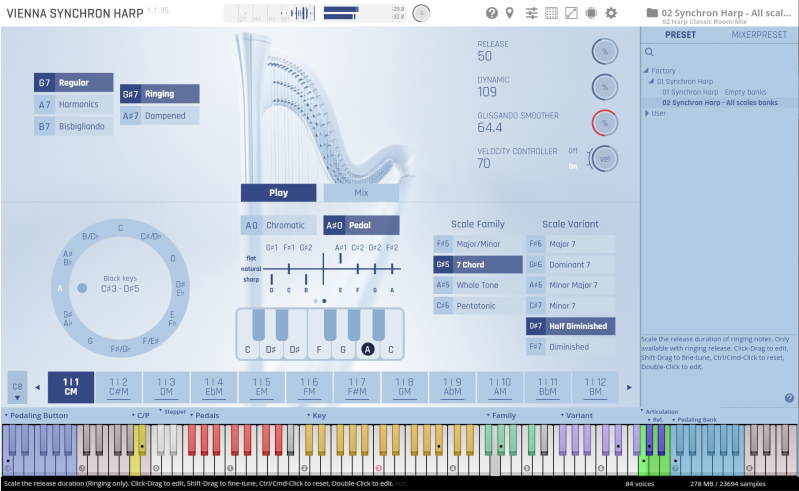Vienna Symphonic Library releases Synchron Harp
The Vienna Symphonic Library announces the release of Synchron Harp, a brand-new software instrument featuring a Lyon & Healy Style 30 Concert Grand harp, recorded in the large hall of Synchron Stage Vienna. It comes with the all-new Synchron Harp Player that authentically recreates the pedaling mechanism of a real harp. The new Collection is currently available at introductory prices of €145 (reg. €195) for the Standard Library and €255 (reg. €345) for the Full Library.
The harp is a beautiful instrument, that is also very complex. Even some of the greatest classical composers often found it difficult to write for the harp and its multi-faceted possibilities. The instrument is equally challenging to play. It’s almost impossible to master a demanding piece just by sight-reading, requiring adequate time to prepare and work out the pedaling. On the other hand, a harp can achieve sounds no other instrument can approach, particularly in the hands of a master player in an ideal acoustic environment.
With Tina Žerdin, long-time harpist of the Synchron Stage Orchestra, a wonderful Lyon & Healy Style 30 Concert Grand harp placed in the large hall of Synchron Stage Vienna, and the talent of Chief Recording Engineer Bernd Mazagg, all of the elements were put in place to create the best possible recordings.
But the team’s idea was also to help composers and music creators to write for this instrument and to play it authentically on the keyboard. The goal was to create a software instrument with a user interface that lets anybody play sophisticated harp pieces, even with average keyboard skills.
With this goal in mind, the Vienna team created the Synchron Harp Player. In Chromatic Mode users can play the harp just like any other keyed instrument. In Pedal Mode the software recreates the pedaling mechanism and the scale possibilities of a real harp. The harp’s seven strings of each octave are represented by the white keys of the keyboard. Thus, playing a glissando is as easy as gliding one’s fingers over the white keys as one would on a real harp’s strings.
To control the seven harp pedals in Pedal Mode, there are seven function keys (key switches), with key velocity determining the top, middle and bottom position of each pedal. There are also several additional ways to select pedalizations. Separate key switches can be used to access pre-configured tonalities (C, C#, D, etc.), specify the scale family (major/minor, 7th chord, whole tone, pentatonic) and the scale variant (major, melodic minor, harmonic major, harmonic minor). A Pedal Matrix that holds 144 pre-configured scales and their pedalizations can also be accessed using key switches. Users can also create their own pedalizations and use a stepper when playing live, similar to the stepper of an organ for switching through registrations, one after the other.
Everything the user does in the software player can be done on a real harp, knowing that his or her composition can be performed on the actual instrument. The user interface of the Synchron Harp Player even depicts harp pedal diagrams that are used to notate proper pedalization in a score.
In Chromatic Mode, only the general key switches to change articulations, the release of a note (ringing or damped), and the switch to Pedal Mode are available. So when a user plays the harp like a piano, he or she may quickly want to switch to Pedal Mode for playing glissandos on the white keys, and back again to Chromatic Mode.
For all articulations (regular, harmonic, bisbigliando) two release variants are available – ringing and damped, the latter referring to the harpist stopping the string vibration with the flat hand (étouffer). The ringing decay upon releasing a key can be shortened or lengthened using release control. Dynamic range control reduces or expands the dynamic reaction of the harp to key velocity. The “Glissando Smoother” is activated automatically whenever the software recognizes a glissando, i.e., the quick succession of adjacent notes. Here the attack of the notes can be adjusted to create smoother glissandos, mimicking a harpist gently stroking the strings instead of plucking them. The velocity controller lets users assign key velocity to a CC controller, e.g., the ModWheel, which allows them to create even velocities for all the notes when playing glissandos on a keyboard.
To capture the harp and the wonderful ambience of “Stage A” of Synchron Stage, Vienna’s engineers employed seven separate phase-coherent microphone configurations to provide a broad range of room options. All of them are available as separate channels in the mixer section of the Synchron Harp Player.
Pre-configured mixer presets provide a wide variety of tonal characteristics, from close to ambient, from lush to mysterious, from natural to heavily processed with Signature Presets such as Intimate, Solitary, Muffled, Sharp and many others. As with all Synchron Libraries, users can mix the harp in stereo, 5.1 surround or even Dolby Atmos and 9.1 Auro 3D, or any other immersive audio format.
The Standard Library and the Full Library of Synchron Harp both include the same set of articulations and software functionalities. The difference lies in the number of provided microphone positions.
 How to resolve AdBlock issue?
How to resolve AdBlock issue? 